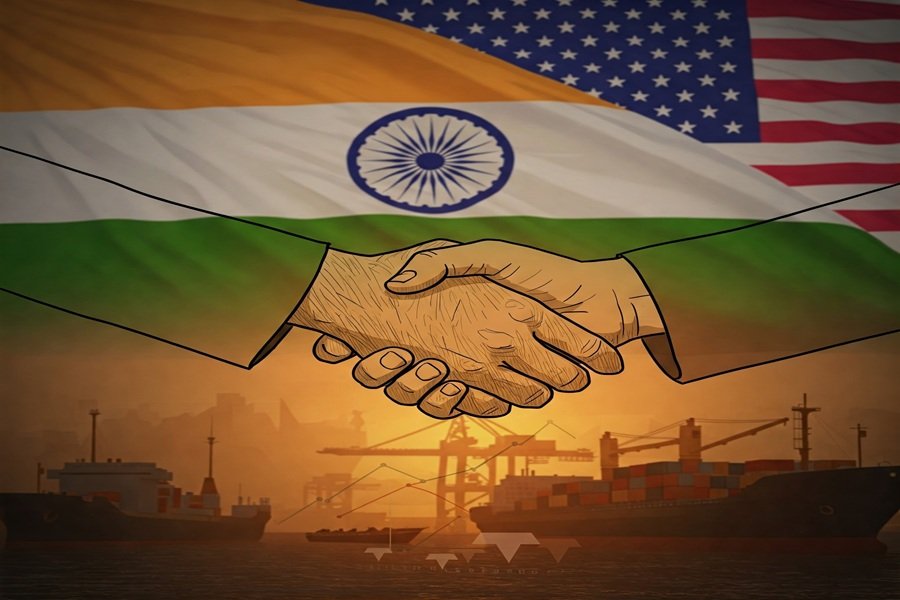
Introduction
In a landmark move to enhance bilateral economic cooperation, India and the United States have officially signed the Terms of Reference for the first phase of a comprehensive trade deal. This development signals a new era of collaboration between two of the world’s largest democracies, aiming to reshape their trade dynamics and address longstanding issues related to tariffs, market access, and strategic investment.
Explore This: https://bharatarticles.com/finance/
Key Highlights of the Agreement
1. Tariff Liberalization
India is preparing to implement significant tariff reductions on over 50% of the $23 billion worth of goods imported from the United States. This move, if enacted, would mark one of the most substantial trade liberalizations undertaken by India in recent years. It is aimed at addressing U.S. concerns regarding the trade imbalance, which currently shows a $45.6 billion surplus in India’s favor.
2. Structured Negotiation Process
The two nations have agreed to begin virtual trade negotiations this month, with face-to-face discussions scheduled for mid-May. Both sides are committed to concluding the first phase of the deal by the end of 2025, paving the way for deeper cooperation and potentially a full-scale trade agreement in the future.
3. Temporary U.S. Tariff Freeze
In a parallel and supportive development, the United States—under President Donald Trump’s administration—has announced a 90-day pause on new tariff hikes for key trade partners, including India. This temporary suspension is designed to provide a conducive environment for meaningful and uninterrupted dialogue.
Strategic and Economic Implications
1. Boost to Bilateral Trade Goals
This agreement aligns with the shared objective of both nations to reach $500 billion in bilateral trade by 2030. With India seeking greater access to U.S. technology and defense sectors, and the U.S. interested in tapping into India’s growing consumer base, the deal could unlock new opportunities in sectors such as pharmaceuticals, agriculture, energy, and digital services.
2. Energy Partnership
In a strategic investment move, Indian energy giant GAIL has expressed interest in acquiring a 26% stake in a U.S. LNG (Liquefied Natural Gas) project. The deal includes a long-term commitment to import 1 million metric tons of LNG annually starting from 2029–2030. This reflects India’s strategy to diversify its energy sources and support cleaner fuel alternatives while helping reduce the trade surplus with the U.S.
3. Defense and Tech Cooperation
India is expected to increase imports of American defense systems and advanced technologies as part of the broader economic cooperation framework. This may include procurement agreements for fighter jets, drone systems, and cybersecurity solutions, strengthening India’s defense modernization program.
Geopolitical Context
Amidst ongoing global trade realignments and rising competition with China, the India-U.S. trade deal underscores Washington’s growing interest in expanding strategic ties with New Delhi. The collaboration also aligns with the Indo-Pacific strategy, wherein India plays a crucial role in maintaining regional stability and ensuring resilient supply chains.
Challenges Ahead
While the agreement marks a significant diplomatic and economic achievement, several challenges remain. These include resolving regulatory hurdles, ensuring compliance with WTO norms, addressing intellectual property rights concerns, and managing agricultural sensitivities in both countries.
Conclusion
The signing of the Phase 1 trade deal between India and the United States is more than a symbolic gesture—it’s a blueprint for a robust and forward-looking partnership. With shared interests in trade, technology, defense, and energy, the deal has the potential to redefine economic ties and set the stage for a more comprehensive bilateral agreement in the near future.
As negotiations progress, the world will be closely watching this strategic alignment, which could become a cornerstone of global economic diplomacy in the coming decade.







